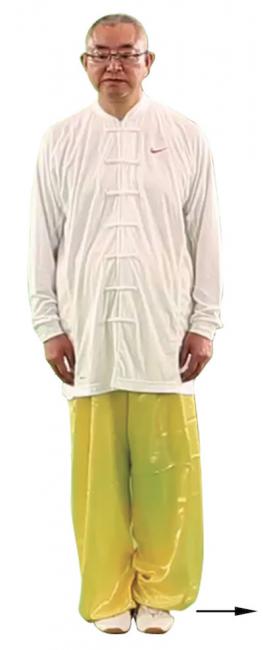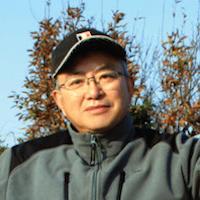Before you begin the sequence it is good to stand in wuji for a moment to focus your intent and your qi.
"Taiji is born from wuji." Wuji can be translated as "having no limits." Be calm and concentrated. Empty the mind. It starts to get obscured and merged. There is no yin or yang, you or others. Stand comfortably and steady as if you were a pole plugged into the sand. At the same time, it feels like riding on a cloud in the sky. You and the earth as one.
- Head: Suspend the head. The Baihui leads up to the sky, with the neck and head relaxed. The baihui is an important cavity located at the top of the head.
- Eyes: Control the look of the eyes. Converge the eyesight. Keep the eyes half closed.
- Tongue: The tongue touches the upper palate. Hold in the lower jaw
- Chest: Open the chest and round the elbows. Relax the breasts (pectorals), feel the shoulders pulled back and down, and the elbows are sunk. The chest should be neutral and the back broadened and relaxed.
- Dantian: Trickle the qi into the dantian, which is located internally in the area below the belly button. That means to focus the intent in the dantian, with the lower abdomen relaxed and filled up. The daimai gradually spreads around. Do not apply any force or work against it. The daimai is the girdle/belt vessel, an energetic circle of qi around the hip area.
- Hips: Round the crotch, with the caudal vertebra pulled downwards, with no upward or forward trend.
- Knees: Apply an upward intent on the knees. Relax the shank muscles.
- Ankles: Relax the ankles. No force should be attached to the ankles. Stand as if the feet are on the duckweed, a plant that grows on the surface of ponds. Do not grab the ground with the toes, but focus the intent deep into the ground.
A beginning in the mind - "Dao gives birth to one, which is taiji."
With a beginning in the mind, slightly open the eyes. Imagine, at a little more than three feet in front of the waist, a round dot gradually starting to shape out of nothing. Then it starts to ascend, with your visual focus until it reaches the eye level, from where it moves left and makes the left foot unintentionally yet naturally taking a step left to put a shoulder width between both feet.
The intent and qi start flowing, making three circles of qi fan outward.
Imagine the chest as two doors, with a small stone clipped in between. When they are opened backwards by the intent, a sudden enlightenment appears. Meanwhile the small stone falls into the lower abdomen, as if a stone tossed into the calm water, which starts rippling. When the inner qi diffuses into the back of the waist, it then keeps spreading sideways till the wrists start to peng. Peng is an action and a feeling of expansion.
The qi keeps moving down to huiyin, a cavity located at the perineum. Then it moves from the upper third of the medial side of the thighs and along the Foot-Tai Yin spleen channel on the medial side of the leg, through sanyinjiao on the medial side of the shanks. Then the qi flows along the foot-shao yin kidney channel through taixi and rangu on the medial side of your ankles down to yongquan, on the bottom of the foot.
Now it moves along the gallbladder channel from the lateral side of the ankles, through the lateral sides of the shanks, and the lateral sides of the knees, continues on the lateral sides of the thighs, then flows up the sides of the hips and daimai. The qi gathers at mingmen from both left and right and sinks into the huiyin, and then goes up to the midpoint between the hips (dantian). Then with the ascending line of the intent and qi as the center, use the intent to guide the inner qi to spread a circle of qi around the hips radiating about three feet. Meanwhile the qi at the center of the hip circle keeps moving up to the waist and fans out into a waist circle radiating about three feet. The qi at the center of the waist circle keeps moving above the chest and spreads into a shoulder circle radiating about three feet.
The following is a list of Yang Style Lao Liu Lu Forms that are intended to provide a simple sequence that you can use to practice the mind approach to taijiquan. Even if you prefer a different taiji sequence, the mind approach can be a powerful way to deepen your training. The mind approach will enhance your art and help create more joy in your practice. The information I have gathered will assist you whether you are about to enter or have already entered the real world of taijiquan. To get to the essence of taijiquan, remember to study the theories and embrace your practice with an open and peaceful mind.
List of Yang Style Lao Liu Lu Forms
- Commencing Form
- Left and Right Parting the Wild Horse's Mane
- White Crane Spreads Wings
- Left and Right Brush Knee and Twist Step
- Strum the Lute
- Left and Right Retreat and Repulse Monkey
- Left and Right Grasp the Peacock's Tail
- First, Second and Third Open and Close Cloud Hands
- Single Whip (Rolling, Rubbing, Folding, Grinding)
- High Pat on Horse
- Right Splitting Foot
- Punch the Ears with Fists
- Left Kick
- Left and Right Fair Lady Works the Shuttle
- Downward Posture
- Rooster Stands on One Leg
- Needle on Sea Floor
- Fan Opens on the Back
- Overturn and Throw Fist
- Retreat, Deflect, Parry and Punch
- Seal and Close
- The Cross Hands and Close into Taiji
I share this with you,
The way of taiji is the Dao that governs nature.
Carry yin and hold yang when practicing with the mind approach.
Guide qi with the mind, and the body with qi.
Freedom of body and mind.
Unity of human and heaven.
Practice with intent, qi, and form to nurture vigor, qi, and spirit.
Practice relaxation, flexibility, and steadiness to gain peacefulness within the movements.
Develop wisdom and awareness to enjoy a prolonged life.
Instructions of this esoteric approach benefit all people
The above is an excerpt from The Mind Inside Yang Style Tai Chi: Lao Liu Lu22-Posture Short Form by Henry Zhuang

